#ulster
Text
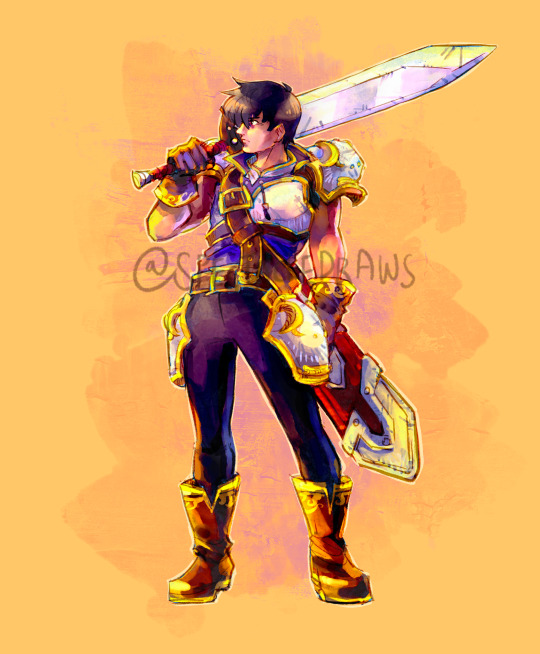
Sketch comm of Scáthach/Ulster for @/LizSbbp on twitter!!
141 notes
·
View notes
Text

Men's fashions for fall and winter 1926-1927 / English Woolen Co.
Catalog featuring clothing from the English Woolen Company located at 1556 Woodward Avenue and 141 Michigan Avenue in Detroit, Michigan.
Burton Historical Collection, Detroit Public Library
#the general effect is exceptionally swagger#swagger#exceptionally swagger#english woolen co.#ulster#detroit#detroit history#illustration#vintage#vintage advertising#english woolen company#1920s#1926#1927#20s#twenties#1920s fashion
103 notes
·
View notes
Text

"My dear Julius... Is there nothing left of my gentle brother?"
A commissioned piece for @whitebloodgames on Twitter! Based on the fic, Her Shadowy Protector. I tried my best to get all the little elements of this huge piece just right and I hope you enjoy how it's turned out! In this scene Scáthach is contemplating how he will save Julia from Loptous' grasp during the events of the game.
I will be reopening for commissions soon (and this would be the time for holiday comms), so keep an eye out on my socials or sign up for my mailing list.
#fire emblem#fe4#genealogy of the holy war#artists on tumblr#art#illustration#jugdral#julia#ulster#scathach#fe#commissions#painted style
114 notes
·
View notes
Text

CROM CASTLE - IRELAND
139 notes
·
View notes
Text
[ Character Impressions 6 (Gen 2) - moar siblings]




- Julia sleepy, Lana sheepy 🐑 they would be the first to fall asleep at a slumber party 😴
- a bit lacklester… 😅 love the hairstyle, we’ll work on personality, and character…
- my Diarmud was… decent. He doesn’t really get to shine as a unit or as a character amidst the other mounted sword wielders.
- love Lachesis -> love Nanna 💘 the bob haircut, the feather accent… SO CUTE!!! 🥰 I wish she promoted to master knight tho (such a cool class)
- I like the way Patty talks and her energy (reminds me of Dew), but some of the things she says are like, “Whoa, gurl. Too far. Back it up or pack it up.” 🙅♀️
- ngl, I was a bit disappointed when I saw Febail for the first time, as Brigid’s son I was expecting… I dunno, blinding beauty. I guess Patty doesn’t have her elegant look either.
- I LOVE THE ISAACH TWINS!!!!! 😍
When you meet them for the first time, I thought Scáthach was the calm, reasonable, more timid (possibly nerdy) twin, and Larcei the feral twin. But then it’s revealed that Scáthach is also a spicy boi, itching to fight, but he’s holding back because of Oifey’s orders. 🥺😩💕
#fe4#fire emblem#geneology of the holy war#first playthrough#first impressions#ayu plays fe4#ayu draws fe4#character thoughts#character impressions#brain worms#Lana#rana#Lester#diarmud#delmud#Patty#Febail#faval#scathach#ulster#larcei#lakche#second generation#feh#fe heroes#judgral
61 notes
·
View notes
Text

Jim Renman #3
Ernest Degner #17
Tom Phillis #19
Ulster GP
#motorcycle#jim renman#ernest degner#tom phillis#motolegends#125cc#honda#mz#sport bike#racing#motorsports#classic motorcycle#built for speed#ride hard or go home#ulster#gp#moto love#lifestyle
72 notes
·
View notes
Text
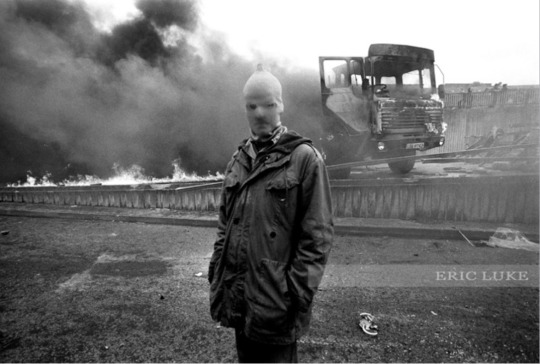
Derry, Northern Ireland in the 70s (Credit: Eric Luke)
#derry#northern ireland#north of ireland#ireland#ulster#the troubles#photography#vintage photography#70s ireland#eric luke#own post
20 notes
·
View notes
Text
The Legend of Cú Chulainn
There are a number of versions of the story of Cú Chulainn’s birth. In the earliest version of Compert C(h)on Culainn (The Conception of Cú Chulainn), his mother Deichtine is the daughter and charioteer of Conchobar mac Nessa, king of Ulster, and accompanies him as he and the nobles of Ulster hunt a flock of magical birds. Snow falls, and the Ulstermen seek shelter, finding a house where they are…

View On WordPress
#Aífe#Cú Chulainn#Celtic Mythology#Co. Armagh#Co. Louth#Conchobar mac Nessa#Emain Macha#Hurling#Irish Mythology#Lady Gregory#Mythology#Navan Fort#Setanta#Ulster
23 notes
·
View notes
Text
Bertie & Elizabeth, flirting...
The Duke & Duchess of York (later King George VI & Queen Elizabeth) pose for formal pictures while on tour in Ulster.
Elizabeth looks over and teases Bertie for looking so serious, which makes him giggle.
Love the little bashful foot shuffle! 💕
Source: British Pathe

(dude in the middle be like, awkward!!)
#king george vi#bertie & elizabeth#flirty bertie#she knows how to make him smile#sweet & shy Bertie#prince albert duke of york#queen mother#elizabeth bowes lyon#duke & duchess of york#1924#1920s#ulster#ireland24#george vi#king bertie#queen elizabeth#sweet moments#british royal family#brf
53 notes
·
View notes
Note
And another question re: Gaelic post…can you talk more about Scots, and how it came to be seen as the more “educated” language compared to Gaelic, as well as how the language is viewed now?
Barrie quaisten!
SCOTS
Scots is another Anglic language closely related to English. There is heated debate (often, unfortunately, along political party lines) over whether it should be considered a language or a dialect. However, the linguistic consensus is that Scots is indeed its own distinct language, complete with its own vocabulary, grammar rules, and historical character. It's akin to the relationship between Danish and Norwegian - while they share a relatively recent common ancestor and have influenced each other over the course of history (however lop-sided that influence may be), they are indeed separate languages.
Around the 600s CE, a new language appeared in the southeast corner of Scotland, back when this area was under the control of certain new-ish arrivals to the island who spoke a Germanic tongue. At this point, Middle Irish (modern Gaelic's immediate ancestor) was the court language of Scotland, and would remain so until the reign of David I, crowned in 1124. Scots is said to have begun diverging from the Northumbrian Old English dialect in earnest by the 1100s, although records of the language are sparse before about 1375 (the beginning of the Early Scots literary period) owing to Viking and English "meddling" (some light raiding here, some plundering there, general theft, and so on). Owing to its Northumbrian origin and heavier Scandinavian influence (stemming from close ties with the Danelaw), Scots has more of an Anglian and Norse character to it as opposed to its relatively more Saxon-y, Norman-y cousin to the south (i.e., English). Scots has also had much closer contact with languages like Scottish Gaelic and even Pictish and Cumbric (which I'll be sure to cover in a future post), and as a result has been influenced in its vocabulary and phonology.
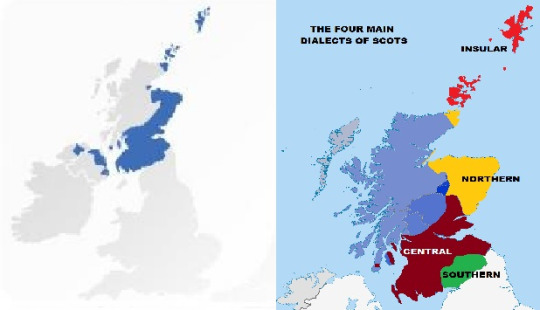
It has several dialects of its own, broadly categorized by location, ranging from Borders Scots to Orcadian Scots and everything in between. (And we can't forget Ulster Scots, a dialect brought to Ulster during the 1600s by Lowlander planters.) Due to this variation, modern Scots has no clear standardized form, though linguists have made several halfway-serious attempts over the past century or so to standardize orthography.
But what's been going on with Scots between David I and the present day? Let's dig in.
David I (in Gaelic, Daibhidh I mac Mhaoil Chaluim), who reigned from 1124 to 1153, initiated the proliferation of proto-urban societies across his kingdom. These societies were called "burghs", or "touns" in Scots, and they'll come in handy later. At about this same time, Norman French began to infiltrate the Scottish nobility, and Gaelic began to decline as a language of prestige among higher levels of society.
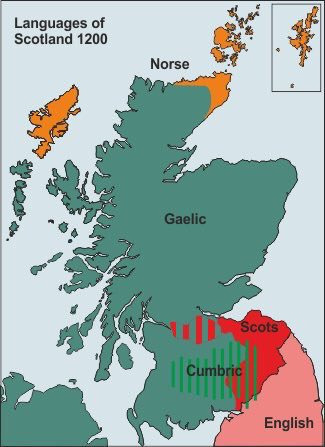
Once the 1200s started to creep around, the northern dialect of Early Middle English that would become Scots began expanding ever northward towards the Forth-Clyde line. This dialect was called "Inglis" by its speakers, and over the next century, it began to supplant Norman French and Gaelic as a common language within the burghs. The 1300s saw this "Inglis" tongue grow in prestige and it began to eclipse Norman French at even the higher levels of society, particularly within the courts. As the 1400s approached, it even began to replace Latin as the language of ecclesiastical and royal court proceedings.
The 1400s saw a relatively rapid geographic spread of Scots at the expense of Gaelic, which was cornered into the Highlands, Western Isles, and small pockets in the Lowlands (viz. Galloway, where Gaelic survived at least up to 1760). By the early 1500s, Scots began to be known as "Scottis", and Gaelic, which had previously been referred to thus, was now being dubbed "Erse" ("Irish") in attempts to otherize Gaelic. The 1500s saw the advent of Middle Scots, which was, in my amateur opinion, the golden era of the language, owing to its undisputed support at all levels of society across most of the kingdom. Around this time, a loose written standard did exist, but the language was still written how it sounded and regional variation was commonplace.

1567, however, saw the coronation of James VI of Scotland (note: James I of England and Ireland as well from 1603 on). His famous Bible translation (KJV) helped to set in motion the gradual Anglicization of Scottish society as it was dispersed among the population. In 1603, the Union of the Crowns brought Scots-speaking and English-speaking nobles into closer contact, and English gradually began to dominate the speech of the Scottish nobility (this exchange would produce what is now Scottish English, a distinct standardized dialect of English that some argue is one end of a linguistic spectrum, at the other end being "braid Scots").
Beginning in 1610 and continuing through to the 1690s, Scottish planters from across the western Lowlands and the Borders began to settle in Ulster, the northeastern region of Ireland. Over time, this group of people would come to develop their own regional identity, the Ulster Scots (or, often in a New World context, Scots-Irish). Their local dialect of Scots, while maintaining a Lowland character, picked up various influences from Hiberno-English (particularly in phonology) and from the Irish language (various contributions of vocabulary).

By about 1700, written Scots, at least in an official capacity, had become almost completely Anglicized. An example of an Anglicized convention introduced to Scots writing is the "apologetic apostrophe", an apostrophe that was inserted into a Scots word where an English-speaking person might expect a letter to be (for example, the Scots word "wi" (in English, "with") would have been written wi'). In 1707, the Acts of Union (Note: Panama played a role) seemed to solidify a shift in the upper-class opinion of the Scots language - what scarcely 150 years before was seen as the national language was now looked down upon by the nobility as "uneducated speech" or "bad English".
However, things looked different from a lower- and middle-class perspective. Contrary to high society, the common people began to take a renewed interest in the Scots language, and a literary revival began. This mid-1700s revival gave us such world-famous names as Robert Burns, Walter Scott, and Thomas Campbell. It was at this time that Scots transitioned from Middle to Modern Scots. However, features such as the apologetic apostrophe were retained during this period to gain wider readership among an English-speaking audience, a market that now effectively spanned the globe. (Meanwhile, the Highlands and Lowlands each experienced their own set of Clearances, and Scotland's diaspora began their journey to the edges of the empire.)
By the early 1800s, this "Scots fever" (NOTE: not a technical term) had reached the upper classes of society as they increasingly turned a Romanticist eye to the literature of their homeland, while simultaneously keeping Gaelic at arm's length. Since this point, there hasn't been any sort of top-level, government-sanctioned, institutional spelling reform or rulebook published on Scots orthography, although this hasn't stopped a wealth of Scots poetry and prose from being published through the years.
Since this era, there has been a relatively steady stream of interest in the language, though recent government initiatives have been taken to attempt to ensure the survival of, and increase interest in, Scots. This 2010 study by the Scottish Government sheds some light on modern public perception of the language within Scotland itself.
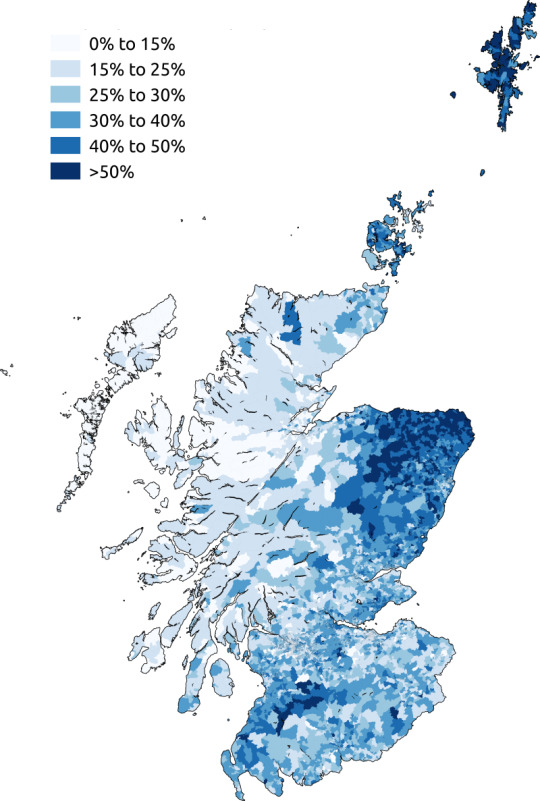
Over in Northern Ireland, the Ulster-Scots Agency was established as part of the wider Belfast Agreement of 1998 in efforts to promote the language and wider culture.

It's not all roses these days, however. A couple of years ago, it came to light that a North Carolina teenager had been, for over seven years, writing entries on the Scots Wikipedia, without any knowledge of the language. One Reddit user remarked that this teenager had caused "more damage to the Scots language than anyone else in history." (Perhaps take this with a grain of salt.)
Would you like to help protect the language?
The best way to protect a language is to learn it! If you click that link, there are several resources for adult learners of Scots to start their journey. My perennial advice, though: once you've got the basics down, use it! Find a Scots speaker and stumble your way through a conversation. Don't be afraid of making mistakes! (Note: everyone makes them.) One resource I've used in the past to learn some basics is the Open University's (entirely free!) Scots language and culture online course. All you need to do is sign up and work through the modules!
Follow for more linguistics and share this post! If you have any questions, feel free to ask!
#scots#scotland#germanic#language#languages#learning languages#langblog#langblr#indo european#united kingdom#ireland#northern ireland#ulster
214 notes
·
View notes
Text
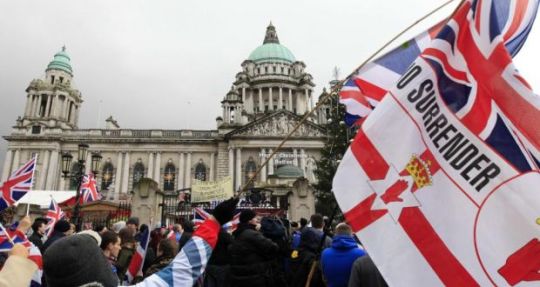
Sinn Fein's victory puts the future of Northern Ireland into question.
#Belfast#Northern Ireland#Sinn Fein#Michelle O'Neill#Ulster#Irish unification#City Hall#protesters#Union flags#politics#Stormont assembly#Eire#Save the Union#United Kingdom
14 notes
·
View notes
Text

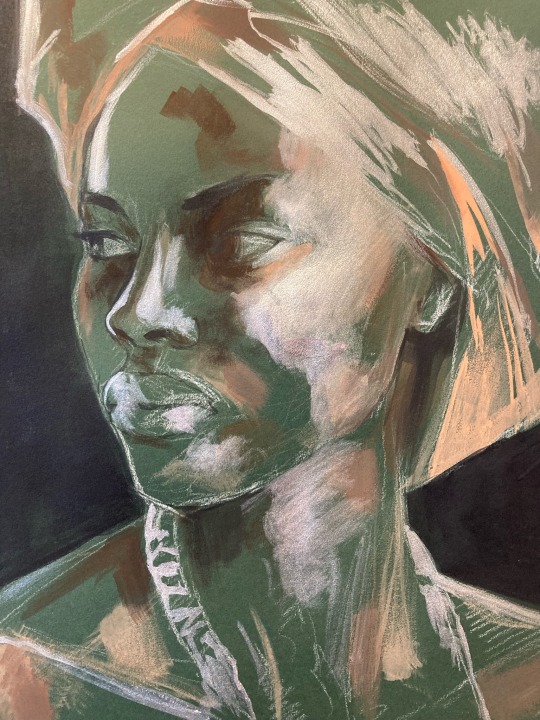

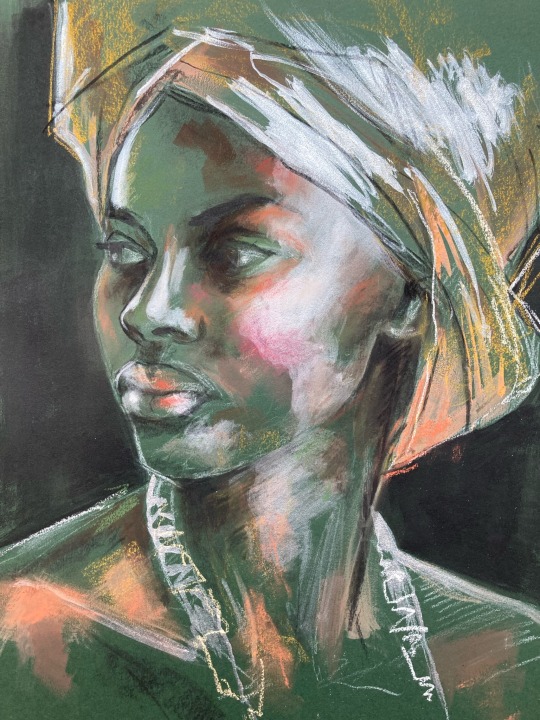
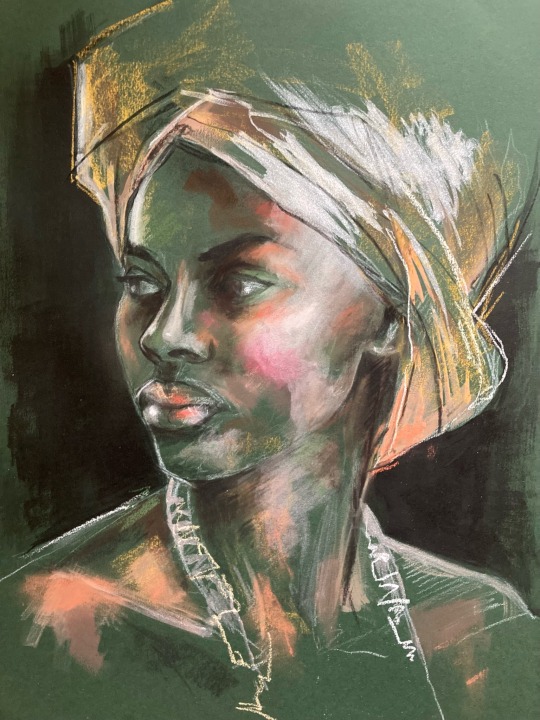
Pastel, gouache, charcoal and pearlescent watercolour portrait BY @ciaraslevin
#art#artwork#northern ireland#artists on tumblr#my art#belfast#contemporary art#drawing#quick sketch#pastel#gouache#watercolour#charcoal#mixed media art#portraiture#lucky number slevin#ulster#drawing faces#portrait painting#love art
31 notes
·
View notes
Photo

Religious Affiliation in the Province of Ulster
48 notes
·
View notes
Text

"Stacking Turf in Donegal" (detail). William Alfred Green. National Museums NI.
9 notes
·
View notes
Text

TITANIC - Photo of the exact replica ataircase shown in the Titanic Museum in Belfast, Ulster, IRELAND
192 notes
·
View notes
Text
i can never tell if all the other dialects hate ulster irish or if ulster irish hates itself tbh
#like girlie#why r u making things harder for urself#and by extension; me#its probs something to do with the ulster plantations and the exposure to scots and english but lets ignore that bc it happening out of#nowhere and ulster irish just deciding to be strange with no explaination is so much funner to think about#ailillgachuair#irish#gaeilgeblr#irishblr#ulster
18 notes
·
View notes